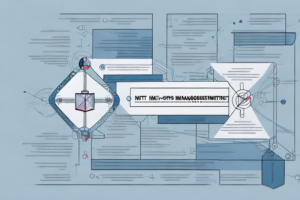What is security control modification strategy plan in RMF?
7 min read
A computer system with a security control modification strategy plan in place
The Risk Management Framework (RMF) is a process-oriented framework designed to manage security and risk in federal information systems. RMF provides the structure for the integration of information security and risk management activities into the system development life cycle (SDLC).
Understanding the Risk Management Framework (RMF)
Risk Management Framework (RMF) is a structured process that involves the identification, evaluation, and prioritization of risks to an information system. It provides a framework for the management of these risks by applying privacy, security, and risk management principles and practices. RMF provides a structured approach to the assessment, management, and monitoring of security risks.
The Importance of Security Control Modification Strategy Plan in RMF
Security control modification strategy plan in RMF enables developing, implementing and maintaining effective security controls. The plan outlines the necessary steps to apply modifications to existing controls, remove old controls or add new controls to ensure the optimal security posture of information systems. It provides a comprehensive framework for the management of security-related risks and ensures that the system meets its stated security objectives.
One of the key benefits of having a security control modification strategy plan in place is that it allows organizations to adapt to changing security threats and vulnerabilities. As new threats emerge, the plan can be updated to include additional controls or modify existing ones to address the new risks. This ensures that the system remains secure and protected against the latest threats.
Another important aspect of the security control modification strategy plan is that it helps organizations to comply with regulatory requirements and industry standards. By following a structured approach to modifying security controls, organizations can demonstrate to auditors and regulators that they are taking the necessary steps to protect their information systems and data. This can help to avoid costly fines and reputational damage that can result from non-compliance.
Common Challenges Faced in Implementing Security Control Modification Strategy Plan
Implementing a Security Control Modification Strategy Plan in RMF comes with its share of challenges. Common challenges include inadequate resources in terms of funding, skilled personnel, or technical infrastructure. In addition, the lack of a proper risk management framework, incomplete or inadequate documentation, and lack of top-level management support are also common challenges.
Another common challenge faced in implementing a Security Control Modification Strategy Plan is the difficulty in keeping up with the constantly evolving threat landscape. As new threats emerge, security controls must be modified to address them. This requires a continuous monitoring and assessment process, which can be time-consuming and resource-intensive. Additionally, ensuring that all stakeholders are aware of the changes and understand their roles and responsibilities in implementing them can also be a challenge.
Key Components of Security Control Modification Strategy Plan
The Security Control Modification Strategy Plan consists of several key components. These components include the identification of security control objectives, the selection of appropriate security controls, the implementation of security controls, security control assessment, ongoing monitoring of security controls, and the development of metrics to measure the effectiveness of the security control modification strategy plan.
One important aspect of the Security Control Modification Strategy Plan is the identification of potential threats and vulnerabilities. This involves conducting a thorough risk assessment to determine the likelihood and potential impact of various security incidents. Based on this assessment, appropriate security controls can be selected and implemented to mitigate these risks.
Another key component of the Security Control Modification Strategy Plan is the establishment of clear roles and responsibilities for security control management. This includes defining who is responsible for implementing and monitoring security controls, as well as establishing procedures for reporting and responding to security incidents. By clearly defining these roles and responsibilities, organizations can ensure that security controls are effectively managed and maintained over time.
Steps Involved in Developing a Comprehensive Security Control Modification Strategy Plan
To develop a comprehensive Security Control Modification Strategy Plan, it’s important to follow a structured approach. This approach typically involves five steps, including setting security objectives, identifying relevant security controls, assessing security control effectiveness, developing a plan for implementing the security controls, and monitoring and continuously reassessing the effectiveness of the security controls.
The first step in developing a comprehensive Security Control Modification Strategy Plan is to set security objectives. This involves identifying the specific security goals that the plan is intended to achieve. These objectives should be specific, measurable, achievable, relevant, and time-bound.
The second step is to identify relevant security controls. This involves reviewing existing security controls and identifying any gaps or weaknesses that need to be addressed. It also involves identifying new security controls that may be needed to address emerging threats or vulnerabilities.
Best Practices for Implementing a Successful Security Control Modification Strategy Plan
Best practices for implementing a successful Security Control Modification Strategy Plan include adopting a risk-based approach, building awareness of security risks, establishing clear roles and responsibilities, ensuring strong communication between stakeholders, using metrics to track progress, and conducting regular reviews to ensure continued effectiveness.
In addition to the above mentioned best practices, it is also important to regularly update and test the security controls to ensure they are effective against new and evolving threats. This can be achieved through regular vulnerability assessments and penetration testing. It is also important to involve all relevant stakeholders in the modification process, including IT, security, and business teams, to ensure that the modifications align with the overall business objectives and do not negatively impact operations.
How to Monitor and Evaluate the Effectiveness of Your Security Control Modification Strategy Plan
Monitoring and evaluating the effectiveness of the Security Control Modification Strategy Plan is critical to ensuring the optimal security posture of information systems. This involves regular risk assessments, the use of metrics to collect data on vulnerabilities, and the use of dashboards to provide feedback on the effectiveness of the strategy. Continuous monitoring helps ensure that the system remains secure against evolving threats.
One important aspect of monitoring and evaluating the effectiveness of the Security Control Modification Strategy Plan is to ensure that the plan is aligned with the organization’s overall security objectives. This can be achieved by regularly reviewing the plan and making necessary adjustments to ensure that it remains relevant and effective.
Another key factor in monitoring and evaluating the effectiveness of the plan is to ensure that all stakeholders are involved in the process. This includes IT staff, security personnel, and business leaders. By involving all stakeholders, the organization can ensure that everyone is aware of the plan and their role in implementing it, which can help to improve overall security awareness and reduce the risk of security incidents.
Benefits of a Well-Developed Security Control Modification Strategy Plan in RMF
Developing a robust Security Control Modification Strategy Plan in RMF has several benefits. These include the reduction of potential vulnerabilities, improvement of overall security posture, alignment with industry best practices, and compliance with regulatory requirements. Additionally, a well-developed plan ensures that risks are identified, assessed, and managed in a systematic and consistent manner, reducing the potential for security-related incidents.
Another benefit of a well-developed Security Control Modification Strategy Plan in RMF is that it helps organizations to prioritize their security efforts. By identifying the most critical assets and systems, organizations can focus their resources on protecting those assets first. This approach ensures that limited resources are used effectively and efficiently, reducing the risk of security breaches and minimizing the impact of any incidents that do occur.
Case Studies: Real-Life Examples of Effective Security Control Modification Strategies in RMF
Real-life examples of effective Security Control Modification Strategies in RMF are numerous. One such example is the enterprise-wide security controls implemented by the Internal Revenue Service (IRS). The IRS implemented a comprehensive set of security controls that include policies, procedures, and technical controls to manage risk. The agency developed a Security Control Modification Strategy Plan that ensures regular assessments and the continuous improvement of security controls.
Other examples of effective Security Control Modification Strategies include those implemented by the Department of Defense (DoD), the National Aeronautics and Space Administration (NASA), and the Department of Energy (DoE). These agencies have implemented robust, risk-based Security Control Modification Strategies that have significantly improved their overall security posture.
In conclusion, Security Control Modification Strategy Plan in RMF is a structured approach to the management of security-related risks. The plan enables the development, implementation, and maintenance of effective security controls. A well-developed Security Control Modification Strategy Plan is critical to ensuring the optimal security posture of information systems and reducing the potential for security-related incidents.
Another example of an effective Security Control Modification Strategy is the one implemented by the Federal Bureau of Investigation (FBI). The FBI has implemented a comprehensive set of security controls that include access controls, encryption, and monitoring tools to protect sensitive information. The agency has also developed a Security Control Modification Strategy Plan that ensures regular assessments and the continuous improvement of security controls.
Furthermore, the Department of Homeland Security (DHS) has implemented a Security Control Modification Strategy that focuses on continuous monitoring and risk management. The agency has implemented a continuous monitoring program that provides real-time visibility into the security posture of its information systems. The program enables the agency to identify and respond to security incidents quickly.



